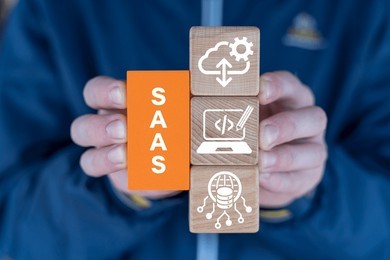In today’s digital landscape, Software as a Service (SaaS) has emerged as a cornerstone of efficiency and accessibility, revolutionizing how businesses operate across various sectors. This article explores the evolution, impact, challenges, and future prospects of SaaS specifically in the realm of content writing.
Understanding SAAS
Software as a Service (SaaS) refers to cloud-based software applications accessed via the Internet, offering scalable solutions without the need for on-premise installation or maintenance. In content writing, SaaS tools have become instrumental in enhancing productivity, collaboration, and content optimization processes.
Historical Evolution
The origins of SaaS can be traced back to the late 1990s and early 2000s when companies began transitioning from traditional on-premise software models to cloud-based solutions. This shift allowed businesses to reduce infrastructure costs, improve scalability, and facilitate remote access to software applications.
As internet connectivity improved and cloud computing technology advanced, SaaS gained momentum across industries, displacing older software distribution models. Today, SaaS platforms are integral to the operations of businesses ranging from small startups to large enterprises, offering a diverse range of applications tailored to specific needs.
Importance and Relevance
In the context of content writing, SaaS plays a pivotal role in streamlining workflows and enhancing content creation processes. Content Management Systems (CMS) like WordPress and Drupal have evolved into sophisticated SaaS platforms that not only manage content but also integrate with a plethora of plugins and tools for SEO, analytics, and collaboration.
The relevance of SaaS in Content Marketing lies in its ability to empower writers and marketers with intuitive tools for content planning, creation, distribution, and analysis. By leveraging SaaS, organizations can achieve greater efficiency, consistency, and scalability in their content strategies, thereby maximizing ROI and audience engagement.
Types and Categories
Content Management Systems (CMS)
Leading CMS platforms such as WordPress, Joomla, and Squarespace have transitioned from standalone software installations to cloud-based SaaS models. These platforms offer robust features for content creation, management, and customization, catering to diverse user needs from blogging to enterprise-level content management.
Content Optimization Tools
SEO tools and analytics platforms are integral components of SaaS offerings in content writing. Tools like SEMrush, Ahrefs, and Google Analytics provide insights into keyword performance, backlink analysis, and audience behavior, helping marketers optimize content for search engines and enhance visibility.
Trends and Innovations
AI and Machine Learning Integration
Advancements in Artificial Intelligence (AI) and Machine Learning (ML) have revolutionized content creation and optimization. Natural Language Processing (NLP) algorithms enable SaaS platforms to automate content generation, personalize user experiences, and predict content performance metrics. AI-driven tools like Grammarly and Clearscope enhance writing quality and SEO effectiveness.
Blockchain in Content Verification
Blockchain technology is being explored for its potential in ensuring content authenticity and combating digital plagiarism. By leveraging blockchain-based verification systems, SaaS platforms can provide immutable records of content ownership and origin, enhancing trust and transparency in digital publishing.
Challenges and Limitations
Data Security Concerns
While SaaS offers numerous benefits, concerns over data security remain prevalent. Storing sensitive data in the cloud raises cybersecurity risks such as data breaches and unauthorized access. SaaS providers must implement robust security protocols, encryption standards, and compliance measures to safeguard user data and mitigate potential threats.
Integration Complexity
Integrating multiple SaaS applications within an organization’s tech stack can be challenging due to compatibility issues and disparate data formats. Interoperability between different SaaS platforms requires seamless data exchange protocols and API integrations, ensuring cohesive workflows and data synchronization across applications.
Future Prospects
Predictive Analytics in Content Strategy
The future of SaaS in Content Writing will likely see increased adoption of predictive analytics for content strategy optimization. By analyzing historical data and user behavior patterns, SaaS platforms can anticipate content trends, personalize user experiences, and optimize content distribution strategies across channels.
Virtual and Augmented Reality
Emerging technologies such as Virtual Reality (VR) and Augmented Reality (AR) hold promise for transforming content creation and storytelling. SaaS-powered VR/AR platforms enable immersive and interactive experiences, enhancing engagement and brand storytelling capabilities for content marketers.
Comparative Analysis
SaaS vs. Traditional Software Models
Compared to traditional software models with upfront licensing fees, SaaS offers subscription-based pricing models that are more flexible and scalable. Businesses can access SaaS applications on-demand, reducing initial investment costs and scaling resources according to operational needs.
SaaS vs. Open-Source Solutions
Open-source software solutions provide community-driven development and customization flexibility, contrasting with proprietary SaaS platforms that offer standardized features and dedicated support. Businesses must weigh factors like customization requirements, support availability, and long-term maintenance costs when choosing between SaaS and open-source alternatives.
Expert Insights
Industry experts emphasize the transformative impact of SaaS on content creation and marketing strategies. Quotes from thought leaders underscore the importance of adapting to technological advancements, leveraging AI-driven insights, and prioritizing data security in SaaS adoption.
Conclusion
In conclusion, the future of SaaS in content writing promises continued innovation and adaptation to technological advancements. As AI, blockchain, and immersive technologies reshape content creation and distribution landscapes, businesses and content creators must embrace these changes to stay competitive and meet evolving consumer expectations.


